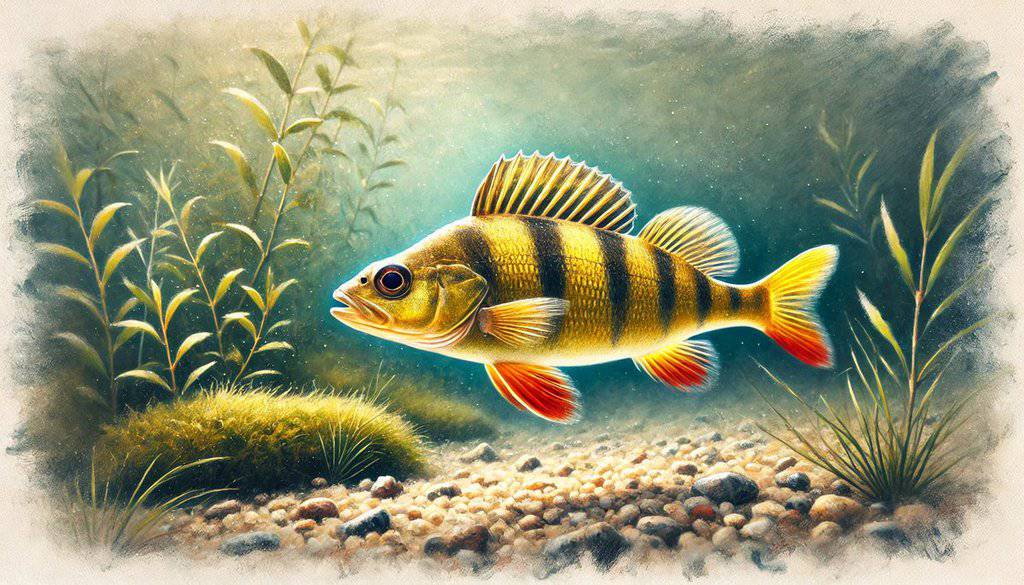Yellow perch is a popular choice for aquaponics systems due to its adaptability and desirable taste. This freshwater fish is known for its mild, sweet flavor and firm white flesh, making it a favorite among fish enthusiasts and culinary experts alike[1]. Yellow perch are well-suited for aquaponics due to their tolerance for a wide range of temperatures and pH levels, as well as their ability to thrive in shallow water environments[1].
Natural Habitat and Behavior
Origin and native environment: Yellow perch are naturally found in cool water lakes, ponds, and slow-moving streams and rivers, particularly in the Great Lakes region[2].
Natural behavior in the wild: In their natural habitat, yellow perch prefer shallow waters and tend to school together[1].
Temperament: Yellow perch are relatively docile and tolerate crowding well in aquaponics systems[2].
Compatibility: Yellow perch can be kept with other cool-water fish species, but care should be taken to prevent cannibalism among differently sized perch[1].
Water Requirements
Temperature Range:
- Ideal temperature: 18-25°C (64.4-77°F)
- Optimal range: 20-25°C (68-77°F)
- For breeding: closer to 21°C (70°F)[1]
pH Level: Suggested pH for cultures 6.5-9.0 [7]
Water Hardness: 50-400ppm [7]
Oxygen Levels: Yellow perch require well-oxygenated water, minimum 3.5 mg/L [7]
Ammonia/Nitrate Sensitivity: Like most fish they are sensitive to both ammonia(<0.0125mg/L [7]) and nitrite (keep as close to 0ppm as possible). Nitrate can be higher, but should be kept under 50ppm)
Tank or Pond Setup
Tank/Pond Size Requirements: Yellow perch prefer shallow water, so a tank with a larger surface area but minimal depth is recommended[1].
Filtration & Aeration: Proper filtration and aeration are essential, especially in high-density setups[2].
Lighting Considerations: A 16-hour light to 8-hour dark photoperiod is preferable to encourage growth in tank culture[2].
Tank Decorations/Substrate: In breeding setups, submerged objects are needed for egg-laying[1].
Feeding Requirements
Diet: Yellow perch are not fussy eaters. They readily consume manufactured feeds and can be easily trained to eat pellets[1][2].
Feeding Techniques:
- Frequency: Not specified in the search results.
- Yellow perch can be pellet-trained quickly and easily[1].
Supplements or special diets: A 27% protein diet has been shown to be optimal for yellow perch grow-out from both biological and economic perspectives[2].
Growth and Reproduction
Growth Rate:
- Yellow perch grow relatively slowly, taking 12-18 months to reach harvest size of about 227g (0.5 lbs) and 10-15 cm (4-6 inches) long[1].
- They can continue growing, reaching up to 1.36 kg (3 lbs) and 25-30 cm (10-12 inches) by 10 years old[1].
Breeding Behavior:
- In nature the male is mature after 1-2 years, while the female is mature withing 2-3 years. [7]
- Yellow perch breed once a year.
- To induce spawning, lower the tank temperature to about 7°C (45°F) for at least a month, then gradually increase temperature and extend light exposure[1].
- Eggs take up to 27 days to hatch[1].
- I recommend reading the external source [7] listed below for more breeding information.
Care of Fry: Newly hatched fry initially survive on their egg sac before moving on to smaller prey[1].
Harvesting & Culinary Considerations
Growth to Harvest: Yellow perch typically reach harvest size in 12-18 months[1].
Culinary Uses: Yellow perch is prized for its delicate white flesh and is popular in the Great Lakes region[2].
Pros and Cons
- Wide temperature and pH tolerance
- Easy to pellet train
- Suitable for shallow water systems
- Docile nature and tolerance for crowding[1][2]
- Slow growth rate
- Potential for cannibalism among differently sized fish
- Challenging breeding process in aquaponics setups[1][2]
Overall Suitability: Yellow perch are suitable for both beginners and experienced aquaponics farmers, especially those in cooler climates or those looking for a fish with a wide environmental tolerance[1][2].
Common Health Issues and Solutions
Yellow perch, particularly under culture conditions, are vulnerable to infection by several pathogenic parasites, bacteria, viruses, and fungi.[7]
Maintenance Tips for Long-Term Health
System checks: Regular monitoring of water temperature is crucial, especially if breeding is desired[1].
Winter/Summer Care: Yellow perch can tolerate a wide range of temperatures, but optimal growth occurs between 20-25°C (68-77°F)[1][2].
Closing Thoughts
Yellow perch is an excellent choice for aquaponics systems due to its adaptability, ease of care, and desirable taste. While they grow slower than some other species, their ability to thrive in various conditions makes them a versatile option for aquaponics enthusiasts in different climates.
More fish species for aquaponics
External sources:
[1] https://www.howtoaquaponic.com/fish/yellow-perch-aquaponics/
[2] https://www.agmrc.org/commodities-products/aquaculture/aquaculture-fin-fish-species/yellow-perch
[3] https://thefishsite.com/articles/species-profile-yellow-perch-perca-flavescens
[4] https://www.fws.gov/species/yellow-perch-perca-flavescens
[5] https://gogreenaquaponics.com/blogs/news/guide-to-raising-yellow-perch-in-aquaponics-systems
[6] https://gogreenaquaponics.com/blogs/news/how-to-raise-cold-water-fish-for-aquaponics-systems-in-colder-climates
[7]https://www.ncrac.org/files/biblio/YellowPerchPub.pdf

